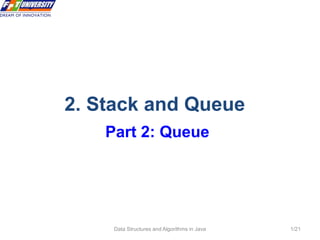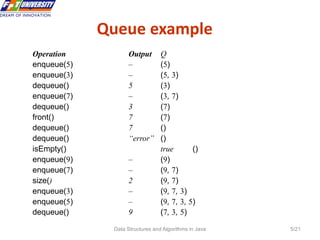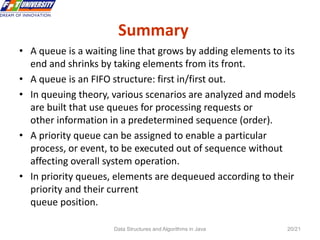The document discusses queues and priority queues. It defines a queue as a waiting line that grows by adding elements to its end and shrinks by taking elements from its front. Common queue operations include enqueue, dequeue, front, clear, isEmpty. Queues follow FIFO order. Priority queues allow elements to be dequeued out of order based on priority. Array and linked list implementations of regular and priority queues are presented. Applications discussed include round robin scheduling, waiting lists, and shared resource access.









![Data Structures and Algorithms in Java 10/21
Array implementation of a queue - 1
10
class ArrayQueue
{ protected Object [] a;
protected int max;
protected int first, last;
public ArrayQueue()
{ this(10);
}
public ArrayQueue(int max1)
{ max = max1;
a = new Object[max];
first = last = -1;
}
public boolean isEmpty()
{ return(first==-1);}
public boolean isFull()
{ return((first == 0 &&
last == max-1) || first == last+1);
}
private boolean grow()
{ int i,j;
int max1 = max + max/2;
Object [] a1 = new Object[max1];
if(a1 == null) return(false);
if(last>=first)
for(i=first;i<=last;i++) a1[i-first]=a[i];
else
{ for(i=first;i<max;i++) a1[i-first]=a[i];
i = max-first;
for(j=0;j<=last;j++) a1[i+j]=a[j];
}
a = a1;
first = 0;
last = max-1;
max = max1;
return(true);
}](https://image.slidesharecdn.com/2b-queues-211112020548/85/2-b-queues-10-320.jpg)
![Data Structures and Algorithms in Java 11/21
Array implementation of a queue - 2
11
void enqueue(Object x)
{ if(isFull() && !grow()) return;
if(last == max-1 || last == -1)
{ a[0] = x; last=0;
if(first==-1) first = 0;
}
else a[++last] = x;
}
Object front() throws Exception
{ if(isEmpty()) throw new Exception();
return(a[first]);
}
public Object dequeue() throws Exception
{ if(isEmpty()) throw new Exception();
Object x = a[first];
if(first == last) // only one element
{first = last = -1;}
else if(first==max-1)
first = 0;
else
first++;
return(x);
}](https://image.slidesharecdn.com/2b-queues-211112020548/85/2-b-queues-11-320.jpg)






![Data Structures and Algorithms in Java 18/21
Array implementation of a priority queue - 1
18
class PriorityQueue
{ protected float [] a; int top, max;
public PriorityQueue()
{ this(50);
}
public PriorityQueue(int max1)
{ max = max1;
a = new float[max];
top = -1;
}
protected boolean grow()
{ int max1 = max + max/2;
float [] a1 = new float[max1];
if(a1 == null) return(false);
for(int i =0; i<=top; i++)
a1[i] = a[i];
a = a1;
return(true);
}
public boolean isEmpty()
{ return(top==-1);}
public boolean isFull()
{ return(top==max-1);}
public void clear()
{ top=-1;}
public void enqueue(float x)
{ if(isFull() && !grow()) return;
if(top==-1)
{ a[0] = x; top = 0;
return;
}
int i = top;
while(i>=0 && x<a[i])
{ a[i+1] = a[i];
i--;
}
a[i+1] = x; top++;
}](https://image.slidesharecdn.com/2b-queues-211112020548/85/2-b-queues-18-320.jpg)
![Data Structures and Algorithms in Java 19/21
Array implementation of a priority queue - 2
19
public float front()
{ assert(!isEmpty());
return(a[top]);
}
public float dequeue()
{assert(!isEmpty());
float x = a[top];
top--;
return(x);
}](https://image.slidesharecdn.com/2b-queues-211112020548/85/2-b-queues-19-320.jpg)

